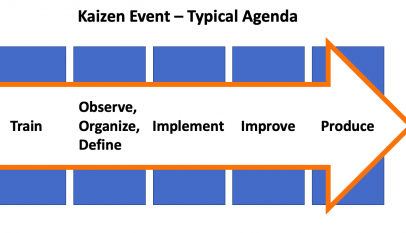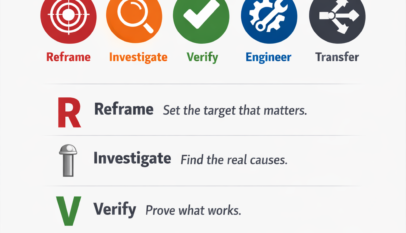Kaizen events effectively bring operational improvements and cost savings to an organization or even into your life. The word “Kaizen” is a Japanese word which means improvement.
These events are a key tool in the Kaizen process and involve teams of employees and stakeholders working together to identify and quickly implement changes to processes or systems. It helps to grow and make success planned and consistent for you.
Today, I will try to cover every aspect related to kaizen events, including the goals, roles, planning and challenges. So, let’s dig in.
What is a Kaizen Event?
A Kaizen event is a process of improvement where a team is involved. It’s a way to identify and implement changes to existing processes that can help an organization improve performance, reduce costs, and increase customer satisfaction. Kaizen events use various techniques to identify improvement opportunities, such as brainstorming, root cause analysis, and brainstorming.
Kaizen events typically involve teams of employees and stakeholders from different departments. The team is responsible for identifying and implementing changes to existing processes. Kaizen events are usually time-limited and often take place over days. The team is usually given a goal to achieve and a timeline to work towards. Kaizen events can involve both short-term and long-term improvements.
Kaizen Event Examples
Kaizen events are one way to bring about process improvement quickly.
Examples of Kaizen events include identifying ways to reduce waste in a manufacturing process, streamlining an administrative process, or improving customer service.
Kaizen events can also be used to identify and implement cost savings, quality improvements, and increased customer satisfaction.
Benefits of Kaizen Events
Kaizen events can bring about a variety of benefits for an organization. These include:
Improved efficiency and effectiveness
Kaizen events can help to identify and eliminate waste in processes and systems.
Increased Customer Satisfaction
Kaizen events can help to identify and address customer issues, leading to increased customer satisfaction.
Improved Morale
Kaizen events provide an opportunity for employees to work together as a team and make a positive impact on the organization.
Increased Innovation
Kaizen events can help to identify and implement new ideas and processes, leading to increased innovation.
Kaizen Event Planning Steps
Kaizen events require careful planning and preparation. This includes setting goals, identifying team members, and developing a timeline. Let’s see the steps you need to get through.
Set Up The Goals
Set the goal you need to start in your Kaizen events. The first and foremost step will help you to get an outline for you and your team.
Choose Your Team
Secondly, you must choose suitable team members who will take the event as their responsibility.
Make A Timeline
Kaizen events are usually time-limited, so it’s important to develop a timeline that outlines when each task needs to be completed.
Identify Resources
Kaizen events require resources, such as materials and equipment. It’s important to identify the resources needed to complete the event successfully.
Develop a Plan of Action
Once the goals, team members, timeline, and resources have been identified, it’s important to develop a plan of action that outlines how the team will achieve the desired outcome.
Kaizen Event Facilitator Role
Kaizen events require a facilitator to ensure that the team works toward the desired outcome. The facilitator oversees the event, provides guidance and support to the team, and ensures the event is successful.
The facilitator should be familiar with the Kaizen process and the tools used. The facilitator should be able to identify opportunities for improvement, provide guidance and support to the team, and ensure that the event is successful.
What Are The Challenges for Kaizen Events?
Kaizen events will undoubtedly be challenging, and there are a few common challenges that you will face. These include:
Scope creep
Kaizen events are typically time-limited and ambitious, and it cannot be easy to achieve the desired outcomes within the allotted time frame.
Resistance to change
Kaizen events involve changing existing processes, and some may resist change.
Lack of resources
Kaizen events require resources, such as materials and personnel, and acquiring the necessary resources cannot be easy.
Lack of knowledge
Kaizen events rely on the knowledge and experience of the team members, and it can be difficult to acquire the necessary knowledge and experience.
Kaizen Event Best Practices
Kaizen events require careful planning and preparation. You need to know the practices for kaizen events which will help you make your mindset.
Set Clear Vision
It’s important to set a clear vision for your Kaizen event. It will ensure you can go through the way, which leads to success.
Identify The Right Team Members
Kaizen events require a team of people with different skills and perspectives. It will help you to make your event run easily and smoothly.
Have a Clear Idea About Your Tasks
Kaizen events are usually time-limited, so it’s important to develop a timeline that outlines when each task needs to be completed.
Identify and Acquire The Necessary Resources
Kaizen events require resources, such as materials and equipment. It’s important to identify the resources needed to complete the event successfully.
Develop A Plan of Action
Once the goals, team members, timeline, and resources have been identified, it’s important to develop a plan of action that outlines how the team will achieve the desired outcome.
Conclusion
Kaizen events are an effective way to bring about operational improvements and cost savings in an organization. They use a variety of techniques to identify opportunities for improvement.
However, Kaizen events can also be challenging, and planning and preparing carefully are important. By understanding what Kaizen events are, the benefits they can bring, and the best practices to follow, you can ensure that your Kaizen events are successful.

















